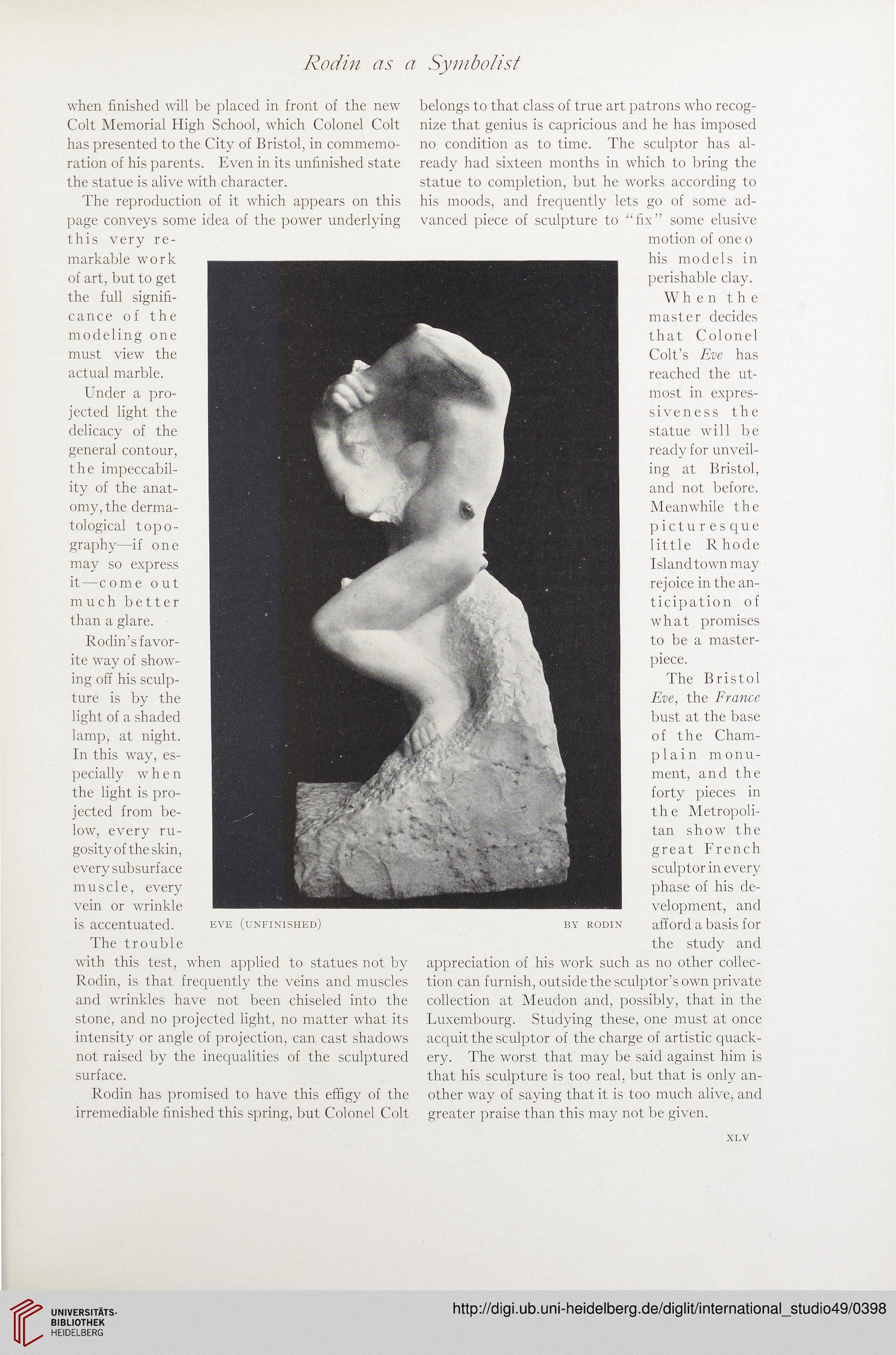Rodin as a Symbolist
when finished will be placed in front of the new
Colt Memorial High School, which Colonel Colt
has presented to the City of Bristol, in commemo-
ration of his parents. Even in its unfinished state
the statue is alive with character.
The reproduction of it which appears on this
page conveys some idea of the power underlying
this very re¬
markable work
of art, but to get
the full signifi¬
cance of the
modeling one
must view the
actual marble.
Under a pro¬
jected light the
delicacy of the
general contour,
the impeccabil¬
ity of the anat¬
omy, the derma¬
tological topo¬
graphy—if one
may so express
it—come out
much better
than a glare.
Rodin’s favor¬
ite way of show¬
ing off his sculp¬
ture is by the
light of a shaded
lamp, at night.
In this way, es¬
pecially when
the light is pro¬
jected from be¬
low, every ru¬
gosity of the skin,
every subsurface
muscle, every
vein or wrinkle
is accentuated.
The trouble
with this test, when applied to statues not by
Rodin, is that frequently the veins and muscles
and wrinkles have not been chiseled into the
stone, and no projected light, no matter what its
intensity or angle of projection, can cast shadows
not raised by the inequalities of the sculptured
surface.
Rodin has promised to have this effigy of the
irremediable finished this spring, but Colonel Colt
belongs to that class of true art patrons who recog-
nize that genius is capricious and he has imposed
no condition as to time. The sculptor has al-
ready had sixteen months in which to bring the
statue to completion, but he works according to
his moods, and frequently lets go of some ad-
vanced piece of sculpture to “fix” some elusive
motion of one o
his models in
perishable clay.
When the
master decides
that Colonel
Colt’s Eve has
reached the ut-
most in expres-
siveness the
statue will be
ready for unveil-
ing at Bristol,
and not before.
Meanwhile the
picturesque
little Rhode
Island town may
rejoice in the an-
ticipation of
what promises
to be a master-
piece.
The Bristol
Eve, the France
bust at the base
of the Cham-
plain monu-
ment, and the
forty pieces in
the Metropoli-
tan show the
great French
sculptor in every
phase of his de-
velopment, and
afford a basis for
the study and
appreciation of his work such as no other collec-
tion can furnish, outside the sculptor’s own private
collection at Meudon and, possibly, that in the
Luxembourg. Studying these, one must at once
acquit the sculptor of the charge of artistic quack-
ery. The worst that may be said against him is
that his sculpture is too real, but that is only an-
other way of saying that it is too much alive, and
greater praise than this may not be given.
EVE (unfinished) BY RODIN
XLV
when finished will be placed in front of the new
Colt Memorial High School, which Colonel Colt
has presented to the City of Bristol, in commemo-
ration of his parents. Even in its unfinished state
the statue is alive with character.
The reproduction of it which appears on this
page conveys some idea of the power underlying
this very re¬
markable work
of art, but to get
the full signifi¬
cance of the
modeling one
must view the
actual marble.
Under a pro¬
jected light the
delicacy of the
general contour,
the impeccabil¬
ity of the anat¬
omy, the derma¬
tological topo¬
graphy—if one
may so express
it—come out
much better
than a glare.
Rodin’s favor¬
ite way of show¬
ing off his sculp¬
ture is by the
light of a shaded
lamp, at night.
In this way, es¬
pecially when
the light is pro¬
jected from be¬
low, every ru¬
gosity of the skin,
every subsurface
muscle, every
vein or wrinkle
is accentuated.
The trouble
with this test, when applied to statues not by
Rodin, is that frequently the veins and muscles
and wrinkles have not been chiseled into the
stone, and no projected light, no matter what its
intensity or angle of projection, can cast shadows
not raised by the inequalities of the sculptured
surface.
Rodin has promised to have this effigy of the
irremediable finished this spring, but Colonel Colt
belongs to that class of true art patrons who recog-
nize that genius is capricious and he has imposed
no condition as to time. The sculptor has al-
ready had sixteen months in which to bring the
statue to completion, but he works according to
his moods, and frequently lets go of some ad-
vanced piece of sculpture to “fix” some elusive
motion of one o
his models in
perishable clay.
When the
master decides
that Colonel
Colt’s Eve has
reached the ut-
most in expres-
siveness the
statue will be
ready for unveil-
ing at Bristol,
and not before.
Meanwhile the
picturesque
little Rhode
Island town may
rejoice in the an-
ticipation of
what promises
to be a master-
piece.
The Bristol
Eve, the France
bust at the base
of the Cham-
plain monu-
ment, and the
forty pieces in
the Metropoli-
tan show the
great French
sculptor in every
phase of his de-
velopment, and
afford a basis for
the study and
appreciation of his work such as no other collec-
tion can furnish, outside the sculptor’s own private
collection at Meudon and, possibly, that in the
Luxembourg. Studying these, one must at once
acquit the sculptor of the charge of artistic quack-
ery. The worst that may be said against him is
that his sculpture is too real, but that is only an-
other way of saying that it is too much alive, and
greater praise than this may not be given.
EVE (unfinished) BY RODIN
XLV




